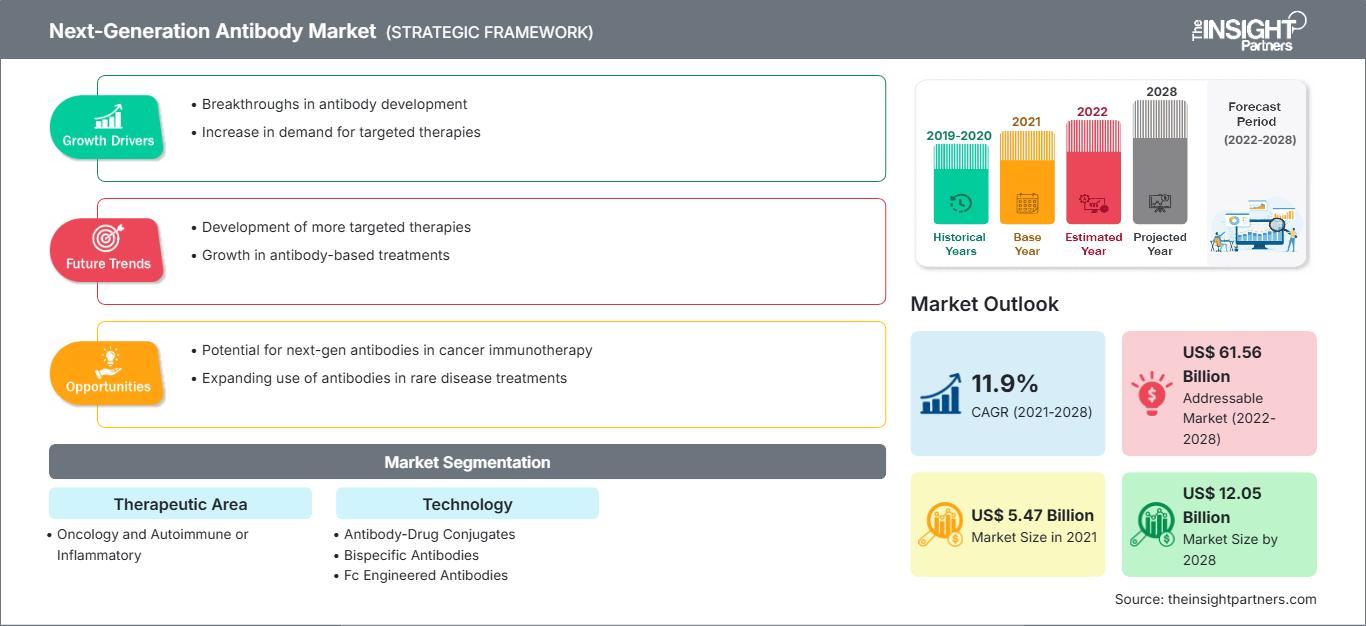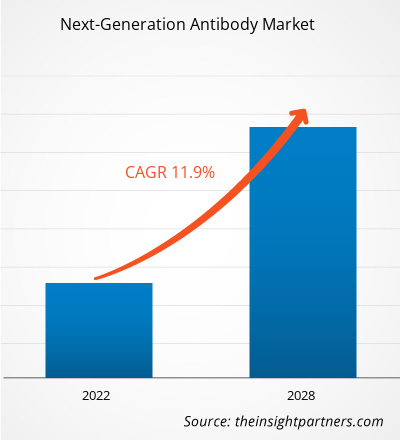Se espera que el mercado de anticuerpos de próxima generación alcance los US$ 12.050,13 millones para 2028, desde los US$ 5.468,41 millones en 2021; se estima que crecerá a una CAGR del 11,9% entre 2021 y 2028.
Los anticuerpos de nueva generación están diseñados para ser más específicos y, a menudo, más potentes que los anticuerpos monoclonales tradicionales. Se requieren estrategias de anticuerpos de nueva generación para diseñar un método terapéutico útil que combine anticuerpo, carga útil, ligador y conjugación, garantizando al mismo tiempo estabilidad, administración dirigida y efectos secundarios limitados.
El informe ofrece información y un análisis exhaustivo del mercado de anticuerpos de próxima generación, haciendo hincapié en diversos parámetros como las tendencias del mercado, los avances tecnológicos, la dinámica del mercado y el análisis del panorama competitivo de los principales actores del mercado a nivel mundial. También incluye el impacto de la pandemia de COVID-19 en el mercado en todas las regiones. La pandemia ha alterado las condiciones socioeconómicas de varios países. Actualmente, Estados Unidos es el país más afectado del mundo debido al brote de COVID-19, con el mayor número de casos confirmados y muertes a nivel mundial, según las estadísticas recientes de la OMS. El elevado número de casos positivos de COVID-19 ha afectado negativamente a las economías mundiales. Se ha producido una disminución de la actividad comercial en general y el crecimiento de diversas industrias que operan en todo el mundo.
Obtendrá personalización en cualquier informe, sin cargo, incluidas partes de este informe o análisis a nivel de país, paquete de datos de Excel, así como también grandes ofertas y descuentos para empresas emergentes y universidades.
Mercado de anticuerpos de próxima generación: Perspectivas estratégicas

-
Obtenga las principales tendencias clave del mercado de este informe.Esta muestra GRATUITA incluirá análisis de datos, desde tendencias del mercado hasta estimaciones y pronósticos.
El brote de COVID-19 ha supuesto una enorme carga para la infraestructura sanitaria en Estados Unidos, Canadá y México. Además, la mayoría de las empresas farmacéuticas y biotecnológicas, así como los institutos de investigación, se dedican al desarrollo de vacunas y fármacos contra la COVID-19. Tanto compañías farmacéuticas consolidadas como pequeñas empresas emergentes se han unido para desarrollar tratamientos y vacunas que combaten la infección causada por el nuevo coronavirus. Como resultado, las actividades de investigación relacionadas con vacunas en empresas farmacéuticas y biotecnológicas, centros de investigación e institutos de investigación educativa se reconocen como esenciales y, en general, no se han visto afectadas en sus operaciones ni en su producción. Sin embargo, debido al aumento de las actividades de investigación, se prevé un aumento tanto en la accesibilidad a la financiación para el análisis como en la necesidad de anticuerpos, incluidos los de nueva generación. Además, a raíz del brote de COVID-19, numerosos investigadores de todo el mundo participan en el análisis viral del SARS-CoV-2, el virus que provoca la COVID-19. Tanto para las vacunas como para las terapias, se examina la eficacia funcional de los anticuerpos generados para contrarrestar el virus diana. Por lo tanto, se espera que la pandemia de COVID-19 tenga un impacto positivo en el mercado de anticuerpos de nueva generación en los próximos años.
Según la región, el mercado de anticuerpos de próxima generación está segmentado en América del Norte, Europa, Asia Pacífico, Medio Oriente y África, y América del Sur y Central.
Perspectivas del mercado
La creciente demanda de terapias con anticuerpos de próxima generación impulsará el mercado de anticuerpos de próxima generación
Los crecientes avances en biotecnología han propiciado una mayor aceptación de las terapias con anticuerpos de nueva generación, lo que impulsa su uso en el tratamiento de enfermedades autoinmunes, inflamatorias y crónicas. Estos tratamientos son el resultado de la aplicación de tecnologías sofisticadas en la terapia con anticuerpos, como los conjugados anticuerpo-fármaco (ADC), los anticuerpos glicoingenierizados y los anticuerpos específicos (BsAb). Por lo tanto, las aplicaciones de los anticuerpos de nueva generación se están estudiando ampliamente para tratar diversas enfermedades crónicas como el cáncer, el VIH y las enfermedades infecciosas. La creciente demanda de estos anticuerpos ha propiciado un rápido aumento en la aprobación de los ADC y otras terapias con anticuerpos de nueva generación. Por ejemplo, en mayo de 2020, Takeda Pharmaceutical Company Limited anunció la aprobación por parte de la FDA de ALUNBRIG (brigatinib) para pacientes adultos con cáncer de pulmón de células no pequeñas (CPNM) metastásico con linfoma anaplásico quinasa positivo (ALK+), detectado mediante una prueba aprobada por la FDA. Con su aprobación, la indicación actual de ALUNBRIG se ha ampliado para incluir el tratamiento de primera línea. ALUNBRIG es un inhibidor de la tirosina quinasa (ITK) de última generación diseñado para atacar anomalías moleculares de ALK. De igual manera, en 2019, Genentech anunció la aprobación acelerada por la FDA de Polatuzumab vedotin-piiq, un conjugado anticuerpo-fármaco dirigido a CD79b, indicado en combinación con bendamustina y un producto de rituximab para pacientes adultos con linfoma difuso de células B grandes en recaída o refractario.
Por lo tanto, se anticipa que el mercado de anticuerpos de próxima generación crecerá rápidamente durante el período de pronóstico debido a las crecientes aprobaciones de ensayos clínicos y la alta adopción de terapias de anticuerpos de próxima generación para el tratamiento de diversas enfermedades.
Perspectivas basadas en áreas terapéuticas
Según el área terapéutica, el mercado de anticuerpos de nueva generación se divide en oncología y enfermedades autoinmunes o inflamatorias. El segmento de oncología representó una mayor cuota de mercado.
Perspectivas basadas en la tecnología
Según la tecnología, el mercado de anticuerpos de nueva generación se segmenta en conjugados anticuerpo-fármaco, anticuerpos biespecíficos, anticuerpos modificados con Fc, fragmentos de anticuerpos y proteínas similares a anticuerpos, y productos de anticuerpos biosimilares. El segmento de conjugados anticuerpo-fármaco tuvo la mayor participación de mercado en 2021, y se estima que este mismo segmento registrará la mayor tasa de crecimiento anual compuesta (TCAC) del mercado, del 12,1 % durante el período de pronóstico.
Los actores del mercado de anticuerpos de próxima generación adoptan diversas estrategias orgánicas, como el lanzamiento y la expansión de productos, para expandir su presencia y cartera de productos en todo el mundo y satisfacer la creciente demanda.
Perspectivas regionales del mercado de anticuerpos de próxima generación
Los analistas de The Insight Partners han explicado detalladamente las tendencias regionales y los factores que influyen en el mercado de anticuerpos de próxima generación durante el período de pronóstico. Esta sección también analiza los segmentos y la geografía del mercado de anticuerpos de próxima generación en América del Norte, Europa, Asia Pacífico, Oriente Medio y África, y América del Sur y Central.
Alcance del informe de mercado de anticuerpos de próxima generación
| Atributo del informe | Detalles |
|---|---|
| Tamaño del mercado en 2021 | 5.470 millones de dólares estadounidenses |
| Tamaño del mercado en 2028 | US$ 12.05 mil millones |
| CAGR global (2021-2028) | 11,9% |
| Datos históricos | 2019-2020 |
| Período de pronóstico | 2022-2028 |
| Segmentos cubiertos |
Por Área Terapéutica
|
| Regiones y países cubiertos |
América del norte
|
| Líderes del mercado y perfiles de empresas clave |
|
Densidad de actores del mercado de anticuerpos de próxima generación: comprensión de su impacto en la dinámica empresarial
El mercado de anticuerpos de nueva generación está creciendo rápidamente, impulsado por la creciente demanda de los usuarios finales debido a factores como la evolución de las preferencias de los consumidores, los avances tecnológicos y un mayor conocimiento de los beneficios del producto. A medida que aumenta la demanda, las empresas amplían su oferta, innovan para satisfacer las necesidades de los consumidores y aprovechan las tendencias emergentes, lo que impulsa aún más el crecimiento del mercado.

- Obtenga una descripción general de los principales actores clave del mercado de anticuerpos de próxima generación
Perfiles de empresas
- F. HOFFMANN-LA ROCHE LTD.
- Compañía Kyowa Kirin, Ltd.
- Seagen Inc.
- ImmunoGen, Inc.
- Compañía farmacéutica Takeda limitada
- Amgen Inc.
- Pfizer Inc.
- Catalent Inc
- AstraZeneca
- Xencor
- Análisis histórico (2 años), año base, pronóstico (7 años) con CAGR
- Análisis PEST y FODA
- Tamaño del mercado, valor/volumen: global, regional y nacional
- Industria y panorama competitivo
- Conjunto de datos de Excel
Informes recientes
Testimonios
Razón para comprar
- Toma de decisiones informada
- Comprensión de la dinámica del mercado
- Análisis competitivo
- Información sobre clientes
- Pronósticos del mercado
- Mitigación de riesgos
- Planificación estratégica
- Justificación de la inversión
- Identificación de mercados emergentes
- Mejora de las estrategias de marketing
- Impulso de la eficiencia operativa
- Alineación con las tendencias regulatorias






















 Obtenga una muestra gratuita para - Mercado de anticuerpos de próxima generación
Obtenga una muestra gratuita para - Mercado de anticuerpos de próxima generación